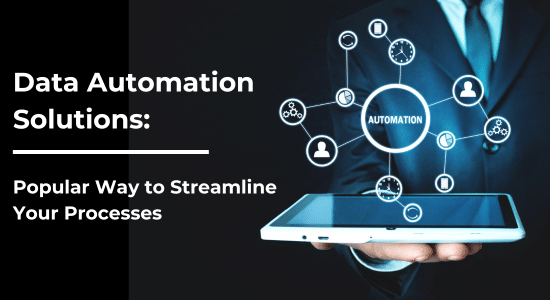Data automation is a key cornerstone for the transformation of businesses. They are necessary for making processes efficient, effective, and accurate. By automating data collection and analysis, businesses can gain a holistic view of their operations.
They can identify trends and patterns that can be easily missed. As a result, there is better decision-making, improved experiences for customers as well as increased revenue.
Fundamentals of Data Automation
Defining Data Automation
Under the umbrella term, Data Automation, falls the whole process of automating data collection, processing, and analysis. To automate manual tasks related to data, various software, tools or technologies are used during this process. This may entail filling in data, cleaning it up, or doing an analysis. Through data automation, organizations can unlock unrivaled productivity and streamline processes, thereby having better outcomes.
Data automation essentially aims at increasing operational efficiency while eliminating errors in handling information. Moreover, this frees up human resources that can be redirected to analytical duties requiring more advanced critical thinking and decision-making skills.
Key Components of Data Automation Solutions
There are three essential components of data automation:
- Extract
- Transform
- Load
Together the components are called ETL, a popular term in the data analytics world.
Extraction
In this stage, data is obtained from different sources such as databases, applications, and many more. Additional sources can be a spreadsheet, a web page, or a PDF. Moreover, today’s technology has brought solutions where APIs or web scraping tools capture information from these sources automatically.
Transform
Data in its crude form is not very usable. In this phase, the gathered information gets processed and turned into a common format/schema. Note that for any tool to read the data and analyze it accordingly; it needs this common readable format. This includes cleaning data like filteration as well as converting it to a consistent structure that could be used across multiple systems.
This undertaking can often be automated through the use of tools that detect common data mistakes—wrong spellings, duplications, varying fields, blank fields, etc.
Load
During the loading stage, the transformed data is put into a target system, after which it becomes available for business intelligence (BI) tools to analyze or make decisions using AI or machine learning.
Benefits of Data Automation
Data automation solutions have a lot of advantages that can save time for businesses, reduce errors and enhance efficiency. Below are some of the key benefits of using data automation solutions:
1. Increased Efficiency
Streamlining your workflow with data automation solutions can automate repetitive actions. This allows you to focus on more important work that needs manual intervention. At the same time data entry, analysis, and processing could be done automatically hence enhancing operations management.
2. Improved Accuracy
Manual data entry is costly and time-consuming. Moreover, it leads to inevitable mistakes. To avoid errors, there are now data automation solutions that automate the process of entering and processing information. By eliminating human input, you observe a decrease in mistakes as well as an improvement in the precision level of your present information.
3. Cost Savings
By decreasing demands for manual labor and improving operational efficiency, data automation solutions can help cut costs. Additional staff requirements can be reduced by automating recurring activities; thus leading to an improvement in your profit margin.
4. Improved Data Quality
The use of data automation solutions can improve your data quality drastically by reducing errors and ensuring consistency. By automating data entry and data processing, these technologies guarantee that data is accurate, up-to-date, and consistent.
Implementation Strategies
It is important to have a clear plan and strategy when implementing data automation solutions to ensure a smooth transition that does not cause hindrance to your operations or your customers.
Here are some key implementation strategies to consider:
Assessment and Planning
Before using any solution for automated data manipulation, you need to examine your current state of affairs. Basically, you need to determine areas that need improvement. This will assist in determining which solution is most appropriate for a given organization.
Furthermore, during the implementation process, it is crucial to plan for any potential challenges or roadblocks, such as acquiring extra personnel or hardware requirements or setting up timeframes.
Integration with Existing Systems
The important thing here is that compatibility should be ensured so that accurate and secure data transfer occurs. All your systems and sources need to be able to speak to each other in order to create a cohesive environment.
As long as your selected data automation solutions integrate seamlessly with existing systems, this should not be a problem. This involves integration into your present software for managing the company’s information along with other pertinent ones, like the CRM tool that your sales and CSM teams might use.
Data Governance and Compliance
When implementing automated tools for handling information, compliance policies must be adhered to as well. That means keeping all the information in protected storage places where only authorized persons are allowed access.
Moreover, it is crucial to observe relevant privacy legislation, i.e., the General Data Protection Regulation (GDPR) and California Consumer Privacy Act (CCPA), which are being followed. It goes without saying, that collaboration with your legal department as well as those responsible for security and compliance, must ensure all criteria are being met for protecting organizational information
Advanced Data Automation Techniques
Machine Learning and AI
Machine learning (ML) and Artificial Intelligence (AI) are the contemporary techniques for automating data operations. Their amazing ability to analyze large amounts of datasets within minutes and make informed decisions based on the patterns is truly a blessing for data-crazy businesses.
ML algorithms can be trained to analyze large amounts of data, identify patterns, and make decisions based on these findings. Further use of artificial intelligence can even automate decision-making through insights gained from ML.
For instance, predictive maintenance, popular in the manufacturing sector, uses both AI/ML. AI can analyze data from sensors on machines and predict when the machine is about to fail hence scheduling for preemptive maintenance. This saves the organizations time and money as they avoid downtimes that would be costly.
Predictive Analytics and Decision Automation
Predictive analytics, on the other hand, employs statistical algorithms. These help analyze past data and predict future events. They can be used in automated decision-making, such as foreseeing customer churn or identifying high-risk transactions.
Decision automation takes this further by using the insights gained from predictive analytics to automate decision-making processes. For instance, an e-commerce firm can apply predictive analytics to detect customers likely to complete purchases, after which decision automation will automate marketing through targeted emails.
Evaluating Data Automation Tools
Picking the right data automation tool for your business depends on a number of factors. Here are some things to consider when assessing various data automation tools:
Criteria for Selection
- Ease of use: The system should be user-friendly and easy to navigate. It must also blend in well with your current systems and ways of working
- Customization: Choose a tool that allows you to tailor-make and mechanize your data processes depending on what you want
- Scalability: Ensure that the system can handle your current data needs and grow with your business’s expansion
- Security: Data must always be secure. Therefore, get a tool that has robust security systems in place to safeguard your information
- Support: Find out if there are enough technical support services, training material, or documentation to enable you to realize its maximum potential
Determining the optimal moment to transition from human effort to data automation is a delicate balance. Generally, automation is effective for tasks that are frequent and rule-based.
For example, determining whether or not to automate an analytic process depends on such factors as what type of data is being analyzed, how complex the analysis is as well as whether it involves repetitive operations or rule based calculations.
Tasks like data cleaning, transformation, and report generation, which involve rule-based operations and frequent repetition, are suitable for automation. Automating analytics has been found particularly beneficial for large datasets because processing these would otherwise require significant human effort.
However, tasks that are one-time occurrences or involve high complexity, such as correlation analysis or cluster identification, still require human expertise for accurate results.









